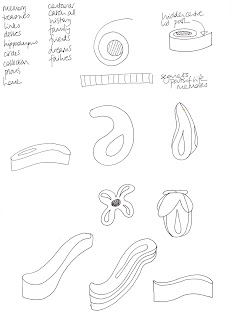This the inside and outside of the final piece.
Overall I am pleased with it as it is brightly coloured, fit for purpose as a treasure chest. The down sides are that the raw edges to the strips are quite fragile and will need some care. It would not be suitable to be used as a standard toy. I like the dimensions as it is striking and the little pyramids are big enough to house an item. I am happy that this is a close representation of the paper mock up and in particular that the sides have the same strong reinforced quality that stops it looking too floppy. I think it is a good contrast that the little pyramids have a softer appearance.
I tried it with further layers of pyramids but it became very 'busy' and I like the effect of finding little brightly coloured jewels in the bottom of the large pyramid.
I wanted to create 'pockets' inside the pyramid in which to hide little family treasures for a child to find. Initially I planned to make fabric pockets but I didn't like the effect. In the end I decided to make a number of small pyramids using 2 different layers of the stiffened fabrics. The apices were particularly difficult to finish neatly so I topped them all with a bead or two. Each pyramid measures approx. 8cm high. These fit neatly into the base of the pyramid as each is a geometric fraction of the original. The pyramids have a different colour lining but the photo doesn't show this very well. Each has an opening along one side allowing you to place an object inside.
It was serendipity that one of the sides was a little shorter than the others so that when it closed up it fits neatly into the apex made by the other 2 sides and miraculously stays there!
I have decided to use this pyramid as a memory box which I could pay with with children in the family . I wanted to create a container so I joined 2 of the sides using ladder stitch. The blue lining shows as an edging to the side panel as in the paper mock-up
As the seams were too thick with any other technique, I laced the fabric on to the card shapes then applied a dark blue fabric to the reverse as a lining. The base was covered in a plain piece of fabric, edged with a machined cord, and the sides ladder stitched to the base.
On Sian's advice I increased the size of the pyramid by half again and the completed piece measures 37cm high and 25cm across each side of the base. I made a net and cut card to fit. I made a sheet of fabric to cover each piece using fabric backed by iron-on heavy weight vilene. Each strip was cut and overlapped on the stripe above. The silk tended to fray more than the cotton so in places I overlapped both edges. I did try normal seams for the strips and edging them in order to reduce the fraying, but the former was too bulky and the latter rather fussy and ugly. I used cotton floss in a matching colour to join the strips together. Having tried a few methods I used reverse applique by cutting tiny windows in the strips and backing the gaps with small pieces of different coloured fabric. I other areas I used small blocks of satin stitch or star shaped stitches.
So now I hand dyed a range of cottons, linen and silk satin to the required colours. I also used a couple of bought fabrics in order to complete the colour range. This is a selection of fabrics used.
 |
| paper and card mock-up |
 |
| colour study |















































